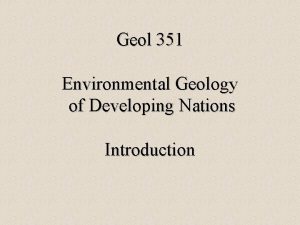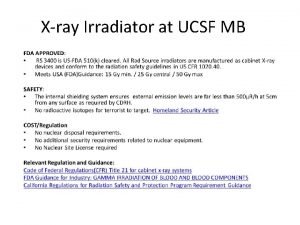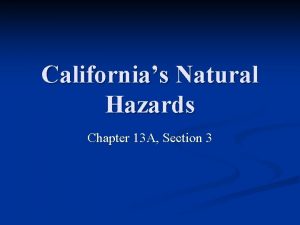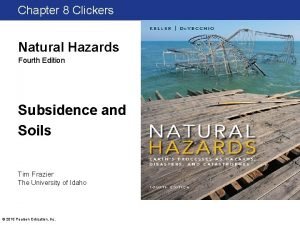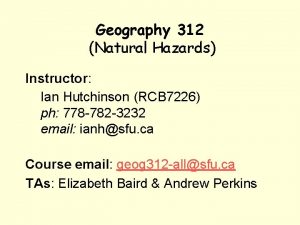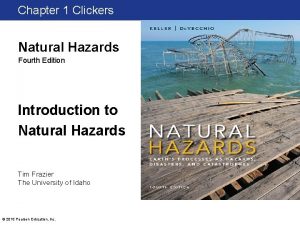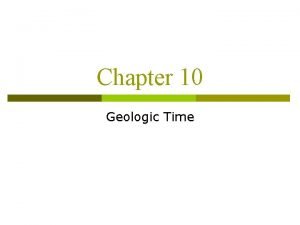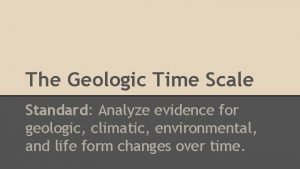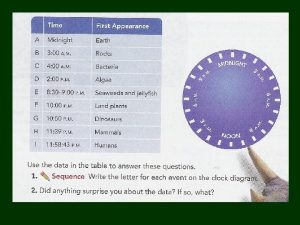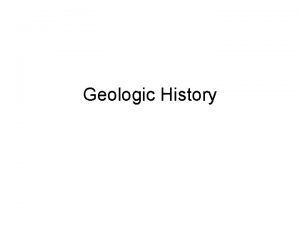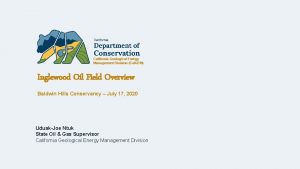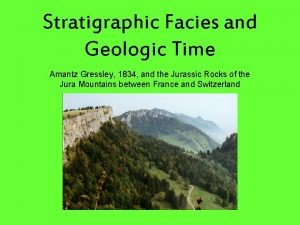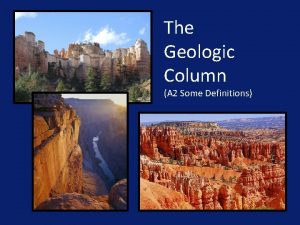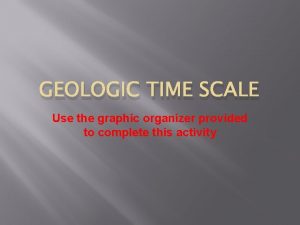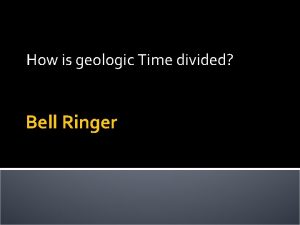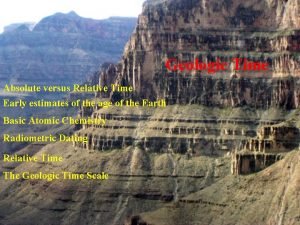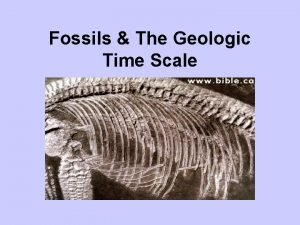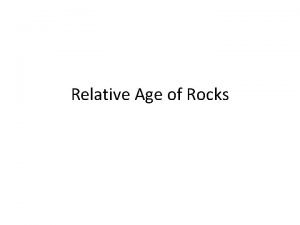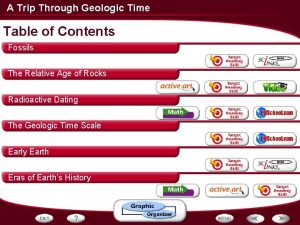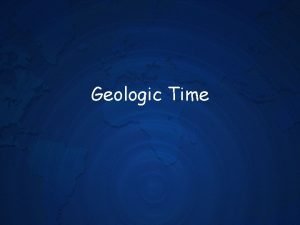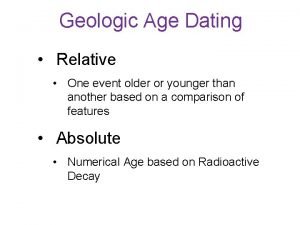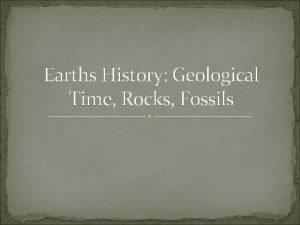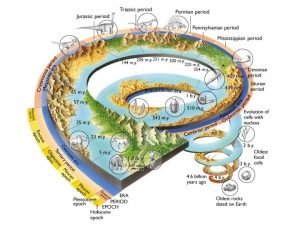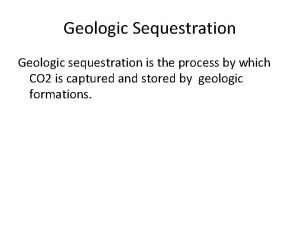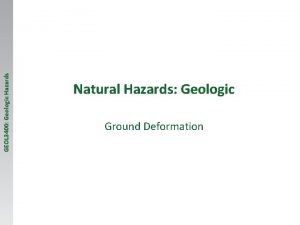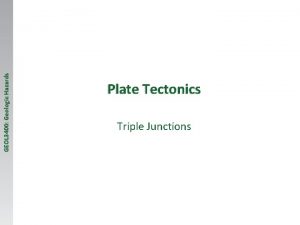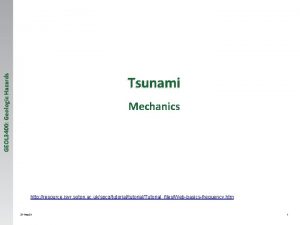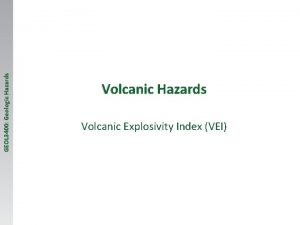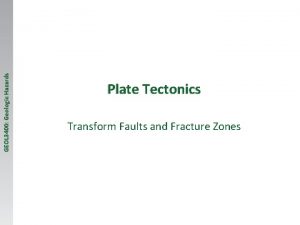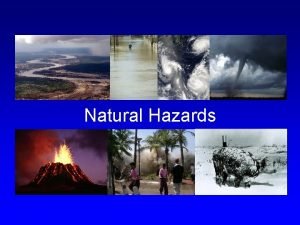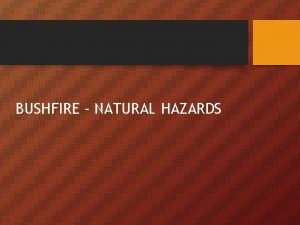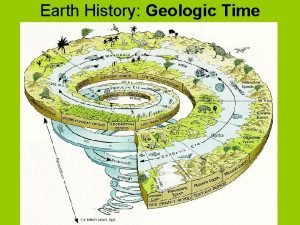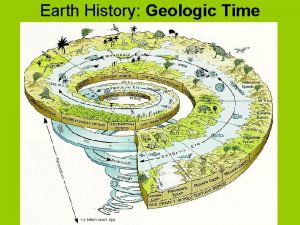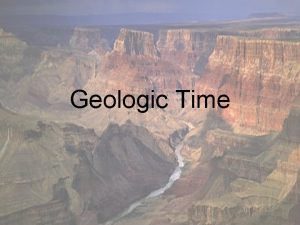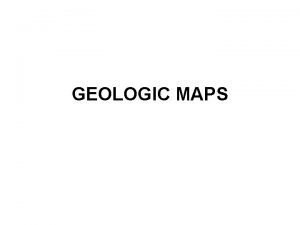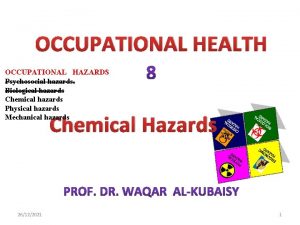GEOL 3400 Geologic Hazards Natural Hazards Geologic Hazards











































- Slides: 43

GEOL 3400: Geologic Hazards Natural Hazards: Geologic Hazards Slope and Surface Failures Slope Failures: Mass Wasting

Geologic Hazards: Slope Failures An Introduction GEOL 3400: Geologic Hazards • material on a slope is unstable and wants to move downslope – most of the time it moves very slowly • sometime large volumes move rapid and with catastrophic results • mass movements or mass wasting are large scale transfer of material downslope under the influence of gravity – slow version is creep – fast variety is landslides • in the United States, mass movement causes $1. 5 billion in damages and 25 deaths yearly • the speed of a mass movement determines its potential for hazardous behavior – slow-moving masses cause property damage but rarely fatalities – in contrast, fast moving masses can produce deaths 21 -Sep-21 2

Geologic Hazards: Mass Wasting GEOL 3400: Geologic Hazards An Introduction 21 -Sep-21 • gravity is the agent that causes downward and outward movement of landslides • force that gravity exerts on a particle or object on a slope is related to the slope of the surface – is the weight of object times sin of angle of slope from horizontal 3

Geologic Hazards: Mass Wasting Types of Mass Movements GEOL 3400: Geologic Hazards • there are three basic types of mass movements: falls: movement of material from a topographic high by free-fall or – falls bouncing slides: movement of a semi-coherent mass along a failure surface – slides flows: any mass that moves like a viscous fluid by flowing down and over a – flows surface • the types of movement exhibited by these types of movements varies: – falls move downward – slides and flows move downward as well as outward 21 -Sep-21 4

Geologic Hazards: Mass Wasting GEOL 3400: Geologic Hazards Types of Mass Movements: Falls • occurs when rock separates from main slope, e. g. cliff, mountain • mass falls through the air via free fall – when it hits the ground it bounds and rolls • some triggers of falls include: – heavy rains – frost wedging – earthquakes • rock falls and small volume avalanches flow horizontally only twice the vertical distance they fall • rock falls with volume of 1 million m 3 often travel long distances – sometimes 25 times vertical fall – long run-out flows of this type are called sturzstorms 21 -Sep-21 5

Geologic Hazards: Mass Wasting GEOL 3400: Geologic Hazards Types of Mass Movements: Falls 21 -Sep-21 • farmers quarried slate from base of mountain until cracks opened up in hillside above • mass began to disintegrate as it fell • hit floor of quarry and disintegrated completely • shot out from mountainside ledge into valley flowed 2, 230 m • processes: fall, jump, surge 6

Geologic Hazards: Mass Wasting GEOL 3400: Geologic Hazards Types of Mass Movements: Slides slides, also known as landslides, occur above a failure surface • slides • basal failure surfaces are: – curved concave upward; or – nearly planar • two types of slides are important – rotational slides – translational slides 21 -Sep-21 7

Geologic Hazards: Mass Wasting Types of Mass Movements: Slides – Rotational Slides GEOL 3400: Geologic Hazards • rotational slides move down and out on curved slip surface – movement is rotational along an axis parallel slope – Swedish circle is arc of circle drawn through the basal surface • used to calculate driving versus resisting forces – doing movement, head of slide moves down and rotates backward • toe moves upward and onto a surface not disturbed by slide – top of slump creates depression in which water can collect • can seep down and lubricate basal surface • increases likelihood of new movement – head of scarp is also unstable and could produce new movement – this type of slide moves only short distance • rotating motion decreases driving mass and increases resisting mass naturally 21 -Sep-21 8

Geologic Hazards: Mass Wasting GEOL 3400: Geologic Hazards Types of Mass Movements: Slides – Rotational Slides 21 -Sep-21 9

Geologic Hazards: Mass Wasting GEOL 3400: Geologic Hazards Types of Mass Movements: Slides – Rotational Slides 21 -Sep-21 10

Geologic Hazards: Mass Wasting GEOL 3400: Geologic Hazards Types of Mass Movements: Slides – Rotational Slides 21 -Sep-21 11

Geologic Hazards: Mass Wasting GEOL 3400: Geologic Hazards Types of Mass Movements: Slides – Rotational Slides 21 -Sep-21 12

Geologic Hazards: Mass Wasting GEOL 3400: Geologic Hazards Types of Mass Movements: Slides – Translational Slides • when mass slides down and outward along surface of weakness it is a translational slide – surface can be joints, faults, clay layer – this type of movement can move as long as it is on the sliding surface and has driving mass • can travel long distances – sliding mass may: • move coherently as a block slide • deform and disintegrate to form debris flow • lateral spreading occurs when underlying material fails and flows causes coherent material to break apart 21 -Sep-21 13

Geologic Hazards: Mass Wasting GEOL 3400: Geologic Hazards Types of Mass Movements: Slides – Translational Slides 21 -Sep-21 14

Geologic Hazards: Mass Wasting GEOL 3400: Geologic Hazards Types of Mass Movements: Slides – Translational Slides 21 -Sep-21 15

Geologic Hazards: Mass Wasting GEOL 3400: Geologic Hazards Types of Mass Movements: Slides – Translational Slides 21 -Sep-21 16

Geologic Hazards: Mass Wasting GEOL 3400: Geologic Hazards Types of Mass Movements: Slides – Translational Slides 21 -Sep-21 17

Geologic Hazards: Mass Wasting GEOL 3400: Geologic Hazards Types of Mass Movements: Slides – Translational Slides 21 -Sep-21 18

Geologic Hazards: Mass Wasting Types of Mass Movements: Flows GEOL 3400: Geologic Hazards • flows are mass movements that behave as viscous fluids – flow is driven by gravity • flows consist of a mixture of sediment, water and air – sediment ranges from large blocks to fine material like snow – water contents vary from dry to saturated • the type of flow varies depending upon the: – proportions of sediment, water and air – physical and chemical properties of the material moving • massive falls often change to highly fluidized flows – rapid flows can kill large numbers of people • two types of flows: – a slurry flow is water saturated – a granular flow is a flow that is not water saturated 21 -Sep-21 19

Geologic Hazards: Mass Wasting GEOL 3400: Geologic Hazards Types of Mass Movements: Flows 21 -Sep-21 20

Geologic Hazards: Mass Wasting GEOL 3400: Geologic Hazards Types of Mass Movements: Flows: Slurry 21 -Sep-21 • a slurry flow is a moving mass of watersaturated sediment – sediment particles are separated and supported by water between them – these flows are dense enough to move boulders in suspension • they can also roll larger blocks – sediment deposit produced when a slurry flow stops is unsorted • that is, the sediment in the deposit is not separated by size 21

Geologic Hazards: Mass Wasting GEOL 3400: Geologic Hazards Types of Mass Movements: Flows: Slurry 21 -Sep-21 • a slurry flow traveling at the slowest velocities, < 1 m/yr are soilfluction • this is the downslope movement of water-saturated soil and regolith • occurs where soil is saturated for long periods of time • recognized on slopes by presence of distinctive lobes, sheets and ridges 22

Geologic Hazards: Mass Wasting GEOL 3400: Geologic Hazards Types of Mass Movements: Flows: Slurry 21 -Sep-21 23

Geologic Hazards: Mass Wasting GEOL 3400: Geologic Hazards Types of Mass Movements: Flows: Slurry 21 -Sep-21 24

Geologic Hazards: Mass Wasting GEOL 3400: Geologic Hazards Types of Mass Movements: Flows: Slurry 21 -Sep-21 • the fastest moving slurry flows are mudflows • the density of mudflows varies from that of a muddy stream to wet concrete – depends on water content • on volcanoes, mudflows are called lahars 25

Geologic Hazards: Mass Wasting GEOL 3400: Geologic Hazards Types of Mass Movements: Flows 21 -Sep-21 26

Geologic Hazards: Mass Wasting Types of Mass Movements: Flows GEOL 3400: Geologic Hazards • granular flows are mixtures of sediment, water and air that are not water saturated 21 -Sep-21 – movement results from contact and collision between grains • they are mostly dry with air not water filling the voids between the sediment grains • the slowest granular flow is creep which moves about 1 cm/yr – most widespread of the mass movements – generally affects soil and uppermost part of the bedrock 27

Geologic Hazards: Mass Wasting GEOL 3400: Geologic Hazards Types of Mass Movements: Flows • creep results from expansion and contraction of soil – expands and moves up perpendicular to the surface • swelling is caused by: – freezing of water in voids – change from water to ice involves a 9 % increase in volume – absorption of water by soil minerals – particularly important when soils include a lot of the clay minerals – volume expansion by solar heating • contracts and moves downslope – shrinkage caused by: • thawing • drying • cooling 21 -Sep-21 28

Geologic Hazards: Mass Wasting Types of Mass Movements: Flows GEOL 3400: Geologic Hazards • creep is controlled by: – presence/absence of plants – animal activity – heating and cooling – wetting and drying • creep is too slow to actually observed – generally recognized by the effects it has on objects resting on the slope – displaced or tilted features, e. g. tilting of telephone poles, displacement of fences • creep is faster, the steeper the slope 21 -Sep-21 29

Geologic Hazards: Mass Wasting Types of Mass Movements: Flows GEOL 3400: Geologic Hazards • graphic 21 -Sep-21 30

Geologic Hazards: Mass Wasting GEOL 3400: Geologic Hazards Types of Mass Movements: Flows 21 -Sep-21 31

Geologic Hazards: Mass Wasting GEOL 3400: Geologic Hazards Types of Mass Movements: Flows 21 -Sep-21 32

Geologic Hazards: Mass Wasting Types of Mass Movements: Flows GEOL 3400: Geologic Hazards • earthflows move with velocities in the range of 1 m/d to about 1 m/hr so they are faster than creep 21 -Sep-21 – commonly occur where the ground is intermittently saturated • often triggered by excessive rainfall – once started, earthflows can continue for days to months to years – earthflows typically head in scarps 33

Geologic Hazards: Mass Wasting GEOL 3400: Geologic Hazards Types of Mass Movements: Flows 21 -Sep-21 34

Geologic Hazards: Mass Wasting Types of Mass Movements: Flows GEOL 3400: Geologic Hazards • debris avalanche is faster than earthflows 21 -Sep-21 – movement of dry or nearly dry granular flow – air fills almost all pores – familiar example is the slip of grains on the face of a dune • the fastest granular flows (< 1 km/hr) are debris flows – these flows are very fast – highly destructive and dangerous events – they are rare and therefore poorly studied 35

Geologic Hazards: Mass Wasting GEOL 3400: Geologic Hazards Causes of Slope Failure • landslide is mass of material whose center of gravity has moved downward and outward • divided into two parts – tear-away zone: zone at top of slope where material has pulled away – pile-up zone: place at base of slope where material that has moved piles up • two types of causes for slides – external – internal 21 -Sep-21 36

Geologic Hazards: Mass Wasting Causes of Slope Failure - External GEOL 3400: Geologic Hazards • three processes that cause slope failure – steepening of slope – removing support from base of slope – adding mass to top of slope • landslides often move above a curved surface – mass that moves can be divided into resisting and driving masses – slope is stable if resisting mass outweighs the driving mass • decrease resisting or increasing driving will cause the slope to fail 21 -Sep-21 37

Geologic Hazards: Mass Wasting GEOL 3400: Geologic Hazards Causes of Slope Failure - Internal • long term processes are attacking the materials that make up a slope – weaken material and can result in failure • these are internal causes of slope failure and include: – inherently weak materials – water in different roles – decreasing cohesion – adverse geologic structures • clay minerals are commonly a cause of slope failure – most common sediment – very small minerals – formed by chemical weathering at the Earth’s surface – clays have layered structure • expand shrink as they absorb and lose water – strength of rock determined by smallest minerals in rock • absorbing water causes clays to weaken • water on outside of grains moves them apart • water absorbed internally expands clay structure and weakens the grips between the layers 21 -Sep-21 38

Geologic Hazards: Mass Wasting GEOL 3400: Geologic Hazards Causes of Slope Failure - Internal • the presence of water weakens Earth materials in several different ways – weight of water filling voids can make slope fail – absorbed internally and externally to weaken surface materials with clays – dissolves material the cements rocks together – groundwater flow can erode material • piping (subsurface erosion) can create extensive cave systems thereby weakening a hill – pore pressure moves grains away from each thereby reducing friction • high pore pressure can cause mass movement or slope failure • quicksand is produced when sand is supersaturated with pressurized water 21 -Sep-21 39

Geologic Hazards: Mass Wasting Causes of Slope Failure - Internal GEOL 3400: Geologic Hazards • slopes may be weak due to pre-existing geologic conditions – these include: • old slide surfaces • rock layering dipping less than slopes • geologic structures within the rock – ancient surfaces are zones of weakness that are reused again and again • often areas of ground-up rock – the orientation of rock layers relative to slope is important in determining where the slope is strong or weak • when units dip less than slope, they will intersect the slope – produces potential surfaces for slipping and mass movement – these are known as daylight bedding – if the layers dip into the slope, they form barriers to movement • rock characteristics that promote mass movement include: – – – 21 -Sep-21 rocks not cemented strongly clay layers provided surface for sliding soft layers sliding off stronger layers joints create weak rock old fault surfaces are potential slide surfaces 40

Geologic Hazards: Mass Wasting Causes of Slope Failure - Internal GEOL 3400: Geologic Hazards • failure generally happens due to a variety of causes – lot of reasons bring slope near to failure – something then triggers the event 21 -Sep-21 41

Natural Hazards: Geologic Dealing with Mass Wasting GEOL 3400: Geologic Hazards • Prediction & Hazard Assessment – reconstruction geologic past to determines where mass-wasting events have occurred in the past – use this to identify areas susceptible – limit the use or types of use of these threatened areas • Prevention & Mitigation – engineering solutions include: • • 21 -Sep-21 retaining walls drainage pipes grading diversion walls 42

Natural Hazards: Geologic GEOL 3400: Geologic Hazards Summary 21 -Sep-21 43
 Compare geologic time with the geologic column.
Compare geologic time with the geologic column. Settelünk geoloogias
Settelünk geoloogias Geol 351
Geol 351 Natural hazards vs natural disasters
Natural hazards vs natural disasters Rs 3400 blood irradiator price
Rs 3400 blood irradiator price 36 nın yüzde 75'i
36 nın yüzde 75'i Dhhs form 3401
Dhhs form 3401 Disclosure deficiency
Disclosure deficiency Least precise number
Least precise number Rs 3400 blood irradiator price
Rs 3400 blood irradiator price Cis 9340
Cis 9340 California natural hazards
California natural hazards How does the study of soils help evaluate natural hazards?
How does the study of soils help evaluate natural hazards? Natural hazards definition ap human geography
Natural hazards definition ap human geography Why is canada rarely impacted by natural weather hazards
Why is canada rarely impacted by natural weather hazards Natural hazards 4th edition
Natural hazards 4th edition Natural capital
Natural capital Chapter 12 geologic time
Chapter 12 geologic time Geologic history
Geologic history The longest subdivision of the geologic time scale is the
The longest subdivision of the geologic time scale is the How is the geologic time scale organized
How is the geologic time scale organized What is earth made out of
What is earth made out of Moth scale
Moth scale Geologic time
Geologic time Original horizontality definition
Original horizontality definition Cal gem
Cal gem Geologic time scale
Geologic time scale Geologic column definition
Geologic column definition Geological time scale graphic organizer
Geological time scale graphic organizer What is the longest subdivision in geologic time
What is the longest subdivision in geologic time Geologic history of texas
Geologic history of texas Geologic time scale
Geologic time scale Geologic time scale animals
Geologic time scale animals Geologic features
Geologic features A trip through geologic time answer key
A trip through geologic time answer key Geologic time scale in a calendar year
Geologic time scale in a calendar year Geologic time scale drawing
Geologic time scale drawing Geologic history
Geologic history Brainpop geologic time
Brainpop geologic time Geologic time scale poem
Geologic time scale poem Geologic time scale
Geologic time scale 4 divisions of geologic time
4 divisions of geologic time Geologic sequestration
Geologic sequestration Funktionshazard
Funktionshazard


